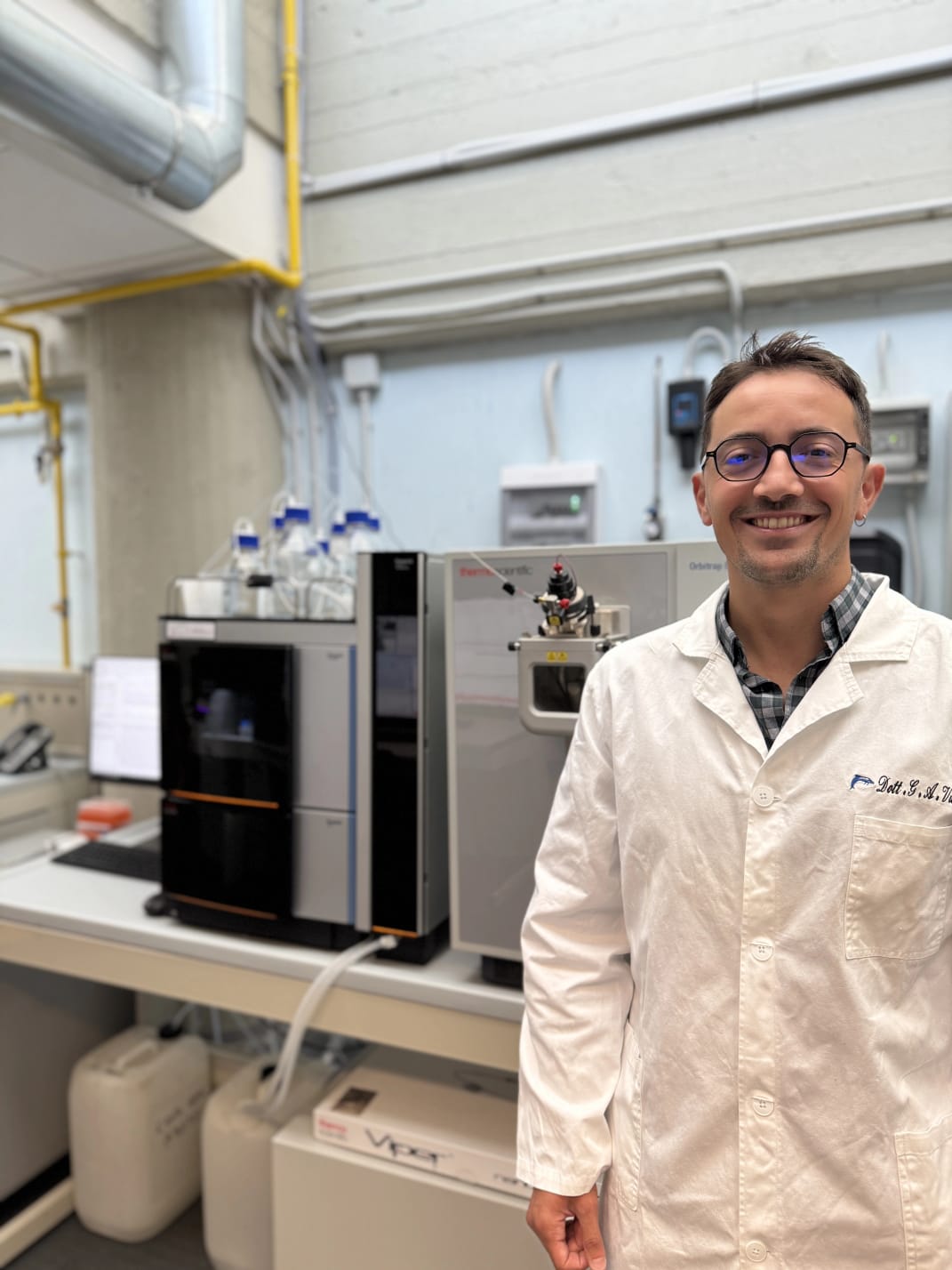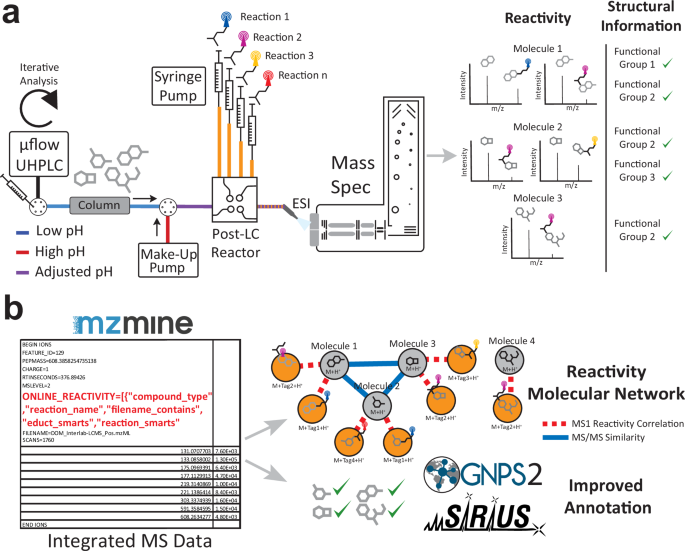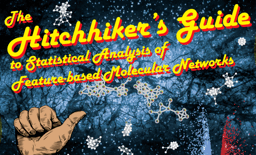Expanding Non-Targeted Metabolomics with Multiplexed Chemical Labeling
Published in Chemistry, Protocols & Methods, and Cell & Molecular Biology

One of the current challenges in LC-MS/MS-based non-targeted metabolomics is the problem that the majority of detected features remain unidentified. High-resolution LC-MS/MS data provides accurate mass, retention time, and fragmentation spectra, but these are often insufficient to unambiguously determine chemical structures, particularly for novel or unknown compounds. Our research groups focus on advancing non-targeted metabolomics workflows to analyze increasingly complex environmental and biological samples (Daniel's group), and on developing new chemical derivatization strategies to enhance natural product discovery and structural elucidation (Chambers' group). A conversation between the two of us at Manu’s coffee cart (famous for serving the best espresso in Tübingen) sparked the foundational idea behind this paper:
What if we could introduce chemical reactivity as an additional layer of information in non-targeted metabolomics, and would this enable us to identify functional groups directly from the data?
That idea became Multiplexed Chemical Metabolomics, or MCheM.
From concept to implementation
MCheM uses selective post-column derivatization to reveal the presence of specific functional groups by triggering predictable mass shifts during LC-MS/MS acquisition. Multiple reagents are introduced in parallel, each targeting a different chemical functionality, such as hydroxyls, amines, or carboxylic acids. This approach adds a reactivity-based data layer that can be directly linked to chemical structure and combined with conventional mass spectrometry signals.
Giovanni Vitale, a joint postdoctoral researcher between our groups, led the development and optimization of the method. Using a comprehensive natural product library provided by Heike Brötz-Oesterhelt, he optimized microfluidic flow control, reagent stability, and reaction conditions. The final setup enabled real-time derivatization without compromising chromatographic performance or sensitivity. With MCheM in hand, Giovanni and Shu-Ning Xia, a graduate student in the Hughes lab, applied the method to a set of specialized metabolites from a Streptomyces strain. The strain, provided by Yvonne Mast at the DSMZ, produced a family of oxazolomycin derivatives that had resisted structural annotation using conventional LC-MS/MS alone. Using MCheM, they observed that the unknown compounds reacted selectively in a single derivatization channel, suggesting the presence of a Michael system. This simple but powerful reactivity clue dramatically narrowed the set of plausible substructures. Combined with spectral analysis, this led to the successful elucidation of the compounds’ scaffolds, offering a clear demonstration of how MCheM can accelerate and improve structure elucidation.

applied the MCheM analysis in the search
for new specialized metabolites.
Integrating chemistry with computational metabolomics
MCheM significantly increases the dimensionality of metabolomics data, presenting new challenges for analysis. To enable broader adoption, we partnered with several computational collaborators to integrate MCheM functionality into open-source metabolomics tools. A key element is the structure-based MCheM reactivity matching in mzmine, which Robin Schmid and Corinna Brungs implemented. With support from Reza Zare Shahneh and Mingxun Wang at UC Riverside, we implemented MCheM enhanced analog matching in the GNPS2 platform. Kai Dührkopp from the Böcker Lab at the University of Jena enabled filtering based on MCheM-derived functional group information in SIRIUS. Together, these implementations allow us to track reactivity across datasets, integrate reactivity patterns with molecular networking, and perform structure-aware annotation at scale.

from MCheM data.
What we learned while implementing MCheM:
- Functional group information provides a powerful filter to reduce annotation ambiguity.
- Post-column derivatization can be performed in real time without compromising chromatographic separation.
- Community-driven software integration is essential to turn a technical method into a widely usable platform.
The MCheM project was a highly interdisciplinary effort made possible only through the dedication of an exceptional team.
This work was a true team effort, led by shared first authors Giovanni Vitale and Shu-Ning Xia, who validated and applied the MCheM platform to natural product discovery. We are especially grateful to Heike Brötz-Oesterhelt for sharing her extensive natural product reference library, and to Yvonne Mast at the DSMZ for providing the oxazolomycin-producing Streptomyces strain. We also thank our outstanding collaborators in computational metabolomics: Kai Dührköpp contributed MCheM functionality to SIRIUS; Corinna Brungs implemented SMARTS-based functional group reactivity matching in MZmine; and Reza Zare Shahneh enabled multi-channel MCheM support in GNPS2. The Wang Lab at UC Riverside supported the broader GNPS2 integration. These contributions were essential to developing a fully integrated and accessible MCheM analysis pipeline for the scientific community.
Looking forward
MCheM began as a collaborative idea and grew into a practical tool through the combined efforts of natural product chemists, mass spectrometrists, microbiologists, and software developers. We hope this method will help the community uncover more structural knowledge about the many unknown compounds in metabolomics data. All reagents and hardware components used in MCheM are commercially available and relatively inexpensive, and all software developed for this project is freely available to academic researchers. Our goal is to make MCheM broadly accessible and adaptable, and we look forward to seeing how the community builds on and applies the tool in new contexts.
Follow the Topic
-
Nature Communications

An open access, multidisciplinary journal dedicated to publishing high-quality research in all areas of the biological, health, physical, chemical and Earth sciences.
Related Collections
With Collections, you can get published faster and increase your visibility.
Women's Health
Publishing Model: Hybrid
Deadline: Ongoing
Advances in neurodegenerative diseases
Publishing Model: Hybrid
Deadline: Dec 24, 2025


Please sign in or register for FREE
If you are a registered user on Research Communities by Springer Nature, please sign in